As environmental consciousness continues to rise across the world, GGA Partner and Chairman of the Board of Directors for Audubon International, Henry DeLozier, identifies the three starting points for clubs looking to make the shift towards a greener future.
Americans are more concerned about climate change than ever before. According to a recent Pew Research Center Survey, “About two-thirds of U.S. adults (67%) say the federal government is doing too little to reduce the effects of climate change, and similar shares say the same about government efforts to protect air (67%) and water quality (68%)…”
The study also found that concern over the state of the environment is more than a national interest or partisan issue, with the majority indicating that climate change is affecting their daily lives, “Most Americans today (62%) say that climate change is affecting their local community either a great deal or some.”
Does the same sentiment exist in golf? Since 2017, managers have reported to GGA that their clubs are under the microscope in some areas, receiving provocation from local municipalities and increased pressure to comply with local rules and environmental regulations. These pressures have led to the need for clubs to increase their ‘green’ efforts in education, labor and training inputs, as well as governmental reporting.
Whether it’s a case of compliance or the desire to develop a greater sense of environmental stewardship and eco-friendly operations, it can often be difficult to know how and where to start. To ease this process, here are three starting points for clubs looking to make the shift towards a greener future.
1. Assess current levels of resource utilization
Understanding how much your club is using, in what areas, from which sources, and at what price is an essential first step.
This will allow you to develop a baseline for evaluation, and measure these against performance goals.
In need of a helping hand to get started? A number of associations and organizations have developed intuitive and informed tools to enable clubs to conduct these evaluations in-house.
- GCSAA’s BMP Planning Guide and Template is an online resource that provides for the development of golf course BMP programs at the state level. Based on a high-potential impact on operation of your facility and its bottom line, GCSAA recommends attention to performance goals in four distinct areas: water conservation, water quality protection, pollution prevention, and energy conservation.
- Audubon International, which promotes sustainability for businesses, recreational properties and communities, has developed Standard Environmental Management Practices that are generally applicable to all golf courses. These standards form the basis for the Audubon Cooperative Sanctuary Program (ACSP) for golf certification guidelines which include habitat planning and management guidance, while increasing the understanding of best management practices for pesticide use.
2. Develop an environmental policy.
“Putting your golf course, community or resort on the path to sustainability may seem overwhelming, but it doesn’t have to be,” Audubon International CEO Christine Kane says. “We suggest starting by establishing an environmental policy that will guide your operations. This will bring your employees and members onboard and pave the way for incorporating topics such as water conservation, IPM or wildlife management into your budget, marketing and maintenance processes.”
3. Seek a certification program and pursue recognition.
Establishing a reputation for environmental stewardship in the public eye – that is, from the viewpoint of your current and potential future members – is a valuable business marketing tool for clubs to wield. Pursuing formal recognition and certification for the club’s commitment to “green” operating practices can grow its market share and build loyalty among the power-spending generations of the future.
If your club is looking to bolster its environmental credentials, here are some awards and programs to consider:
- Audubon launched its Water & Sustainability Innovation Award this year to recognize landscape companies, organizations, and municipalities for sustainable, water-efficient projects. Corica Park South Course of Alameda, California, and its management firm, Greenway Golf, was the first recipient.
- ACSP for Golf provides a tangible form of recognition for clubs and courses committed to protecting the environment and preserving the natural heritage of the game.
- Monarchs in the Rough is a program that partners with golf courses to combat the population decline of the monarch butterfly and to restore pollinator habitat in out-of-play areas.
- The Green Restaurant Association is an international nonprofit organization encouraging restaurants to ‘green’ their operations using science-based certification standards in order to become more sustainable in energy, water, waste, food, chemicals, disposables, and building.
Golf facilities and clubs also benefit from sustainability’s halo effect. Many members today expect greater levels of environmental stewardship from businesses and other organizations with which they are associated. In addition to its environmental impacts, sound resource management and recognition through certification has taken on a good-for-business shine as well.
Research points out that sound environmental stewardship matters to women and millennials especially. While sentiments diverge along lines of on geographic location and political affiliation, it is apparent in the Pew Research study that women and young adults (e.g. Millennials and Generation Z) exhibit a higher propensity to regard climate change as a serious issue which affects them personally.
The bottom line is that that these groups represent the next generation of members and they are both concerned about sound environmental practices and are receptive to learning how club managers are caring for Mother Earth. Clubs and courses seeking to attract younger members would do well to take a responsible approach to environmentalism.




